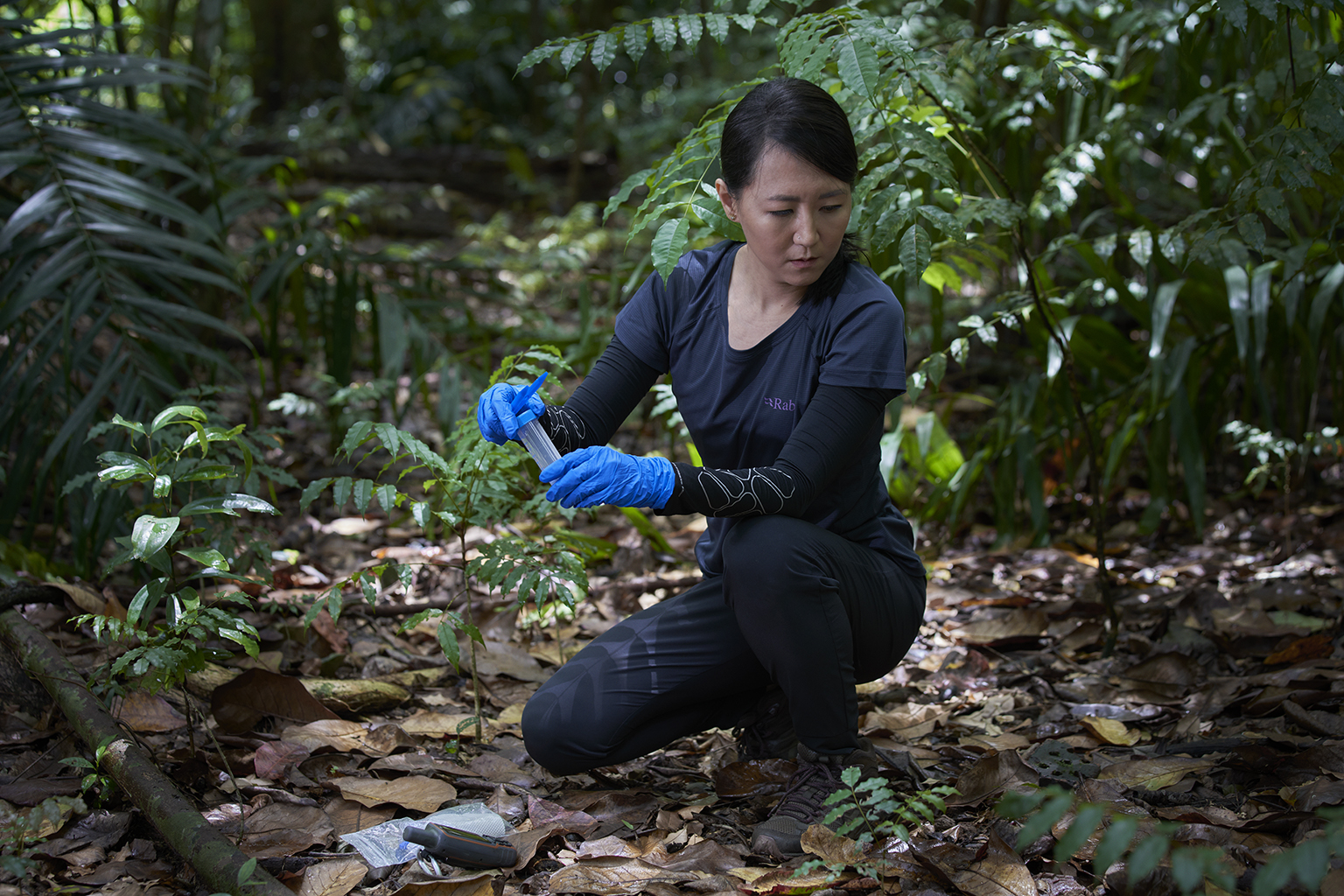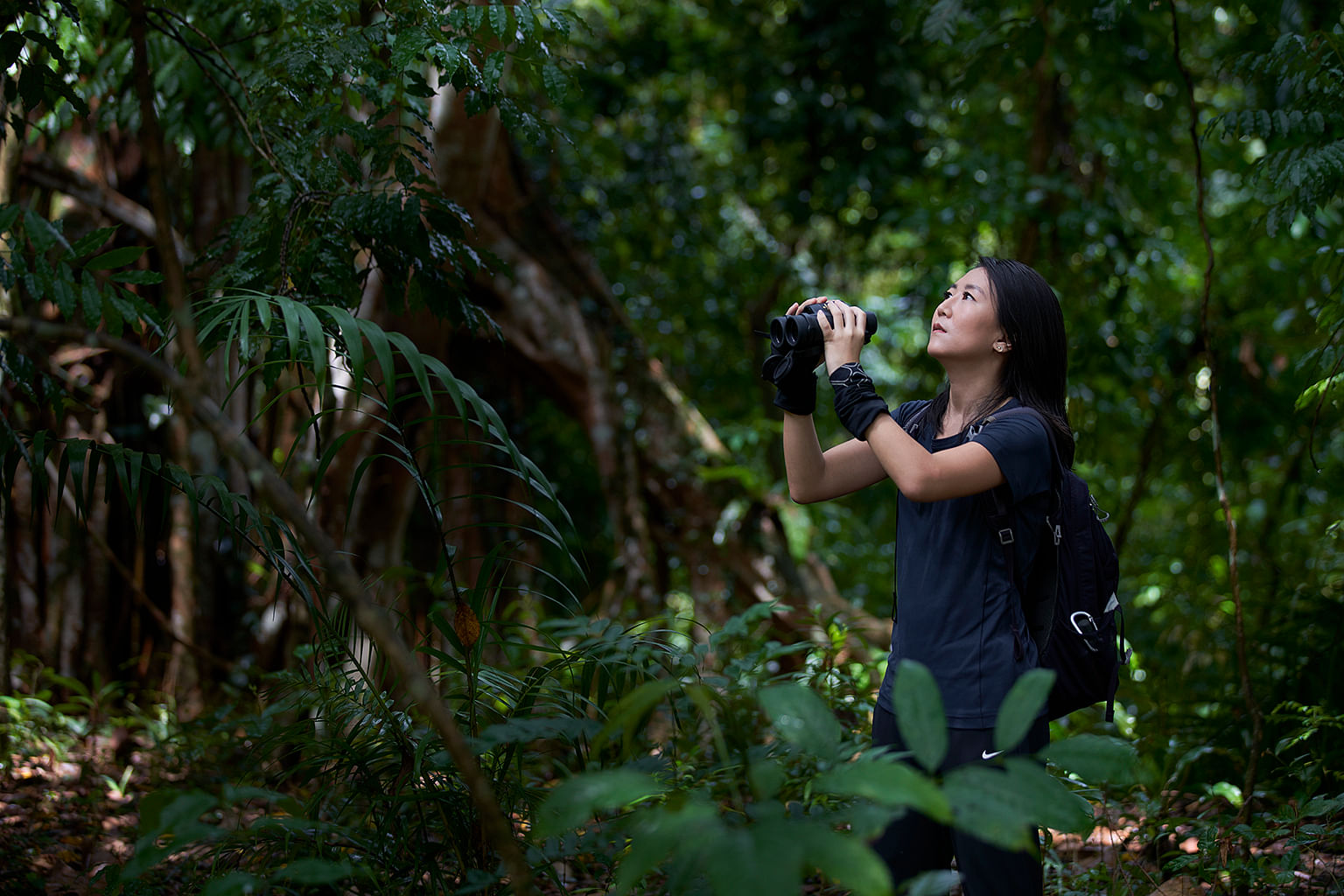IN PARTNERSHIP WITH ROLEX
How her work in saving monkeys is protecting a part of Singapore’s heritage
With only 70 langurs left here, primatologist Dr Andie Ang is on a mission to protect this critically endangered species spotted by Sir Stamford Raffles himself
Sign up now: Get ST's newsletters delivered to your inbox

Primate scientist Andie Ang looks through the monkeys’ faeces, which provide her a rich source of information about their health and population diversity.
PHOTO: SPH MEDIA/BENNY LOH
Follow topic:
When Andie Ang was 10 years old, she had the chance to interact with a vervet monkey, which kickstarted her love for primates.
While she treated it well, she soon realised that it always looked sad and bored.
“After doing some reading about wild monkeys, I knew that I had to return it to its natural habitat,” she says. She contacted the authorities, which helped her to arrange for its release back into the wilderness of Zambia.

“While the episode taught me many things, I'm glad he went back to where he came from, in the African savanna.”
Her childhood memories and experience motivated her to learn more about primates and how to help them – sparking a passion that would soon absorb her.
She enrolled in the National University of Singapore, graduating with a bachelor’s degree in life sciences and a master’s degree in biological sciences. She then went on to earn a PhD in biological anthropology from the University of Colorado Boulder in the US.
A champion for conservation
For the past decade, Dr Ang, 36, has been dedicated to studying primates, including the rare and elusive Raffles’ banded langur found only in Singapore and Malaysia.
People often describe monkeys as naughty, cheeky and aggressive, she notes. “But if you observe them from a distance and see them in their natural habitats, they are cute, interesting and curious. They play around with each other like little kids.
“When we talk about monkeys in Singapore, most people think of the long-tailed macaques, but we have the langurs too. In fact, the langurs were first noted as an undescribed species by Sir Stamford Raffles himself about 200 years ago, and are named after him,” she shares.
She has been working to save the critically endangered species through her many roles. These include a research scientist in Mandai Nature, a wildlife conservation organisation; and as chairperson of the Raffles’ Banded Langur Working Group, which counts representatives from Mandai Nature, the Jane Goodall Institute Singapore (JGIS), Nature Society (Singapore) and National Parks Board (NParks), in addition to volunteering.
The Rolex Awards for Enterprise is a biennial initiative by the Swiss watchmaker, and provides support for people with exceptional projects to improve life on Earth.
With deforestation and urbanisation shrinking the langurs’ habitats, there are only 70 of them in Singapore and likely fewer than 250 in Malaysia. This year, the International Primatological Society named the monkey as one of the 25 most endangered primate species in the world.
Helping to save these creatures have even deeper significance, says Dr Ang, who is also president of JGIS. “We need to recognise that the langur is part of our natural heritage, and protect what we have.”

During Singapore's circuit breaker from April to June 2020, Dr Ang temporarily suspended her field work. Instead of taking a break, she and fellow primate researcher Sabrina Jabbar began writing a book on the langurs based on their research, supported by Mandai Nature.
The 100-page book, Raffles’ Banded Langur: The Elusive Monkey of Singapore and Malaysia, was launched last December. It covers the langurs’ diet, distribution and development, features its habitats from Singapore’s freshwater swamp forest to Malaysia’s primary rainforests, and showcases high-quality photographs of the animals in the wild.
Dr Ang is also leading the JGIS in a national survey, started earlier this year, to find out the public’s views on primates and macaque management measures in Singapore. She explains: “We hope that we can fill in the gaps of what we can do better to help people live in harmony with the monkeys.”One of the ways she’s hoping to close this gap is with community programmes. The JGIS’s Roots and Shoots youth outreach programme for animal welfare and environmental issues, for instance, encourages people to discover more about the langurs through guided walks and its lecture series that brings primate researchers and conservation experts from around the world to Singapore.
Out in the field
Dr Ang’s fieldwork has played a key role in guiding langur conservation efforts in Singapore. During her treks through the Central Catchment Nature Reserve (CCNR), where the langurs live, she records sightings of them, their activities and diet. When NParks reforested Thomson Nature Park near the CCNR prior to its opening in 2019, it utilised her findings to grow plants that langurs eat.
Her photographs of the langurs have also enabled researchers to identify and track individuals. “If the langurs happen to defecate when we come across them, we also collect samples for DNA analysis, to check on their health and monitor the genetic diversity of the population.”

She also takes notes of potential problems for the langurs, such as gaps in canopy cover that may force the tree-dwellers to come down and attempt to cross roads, which puts them at risk of becoming roadkill. “We discuss these with NParks and come up with solutions, like rope bridges that were eventually installed at Old Upper Thomson Road,” she says.
Looking out for the langurs
As the Singapore langur population is low and with limited genetic diversity, making them vulnerable to being wiped out by a disease or harmful change to their habitat, Dr Ang hopes to start a genetic exchange programme between the Singaporean and Malaysian langurs. This would involve moving langurs from both countries, to boost each population’s genetic diversity.

“A lot of planning and coordination needs to go into this to ensure the safety of the langurs and personnel. If there are no rescued langurs already in captivity, we would have to secure a few individuals from the wild,” she explains.
“This requires a good understanding of the home range of the wild langurs, getting them used to our presence, darting and tranquilising them, catching them when they fall from the trees so that they do not get injured, and bringing them to a quarantine facility to do health checks.
“But for the langurs to survive in the long run, especially the population in Singapore, this is something that we definitely need to consider.”
Dr Ang also has a personal goal: to see all 523 primate species that can be currently found in the wild. She keeps a tally of her progress on her website, Primate Watching, where she also provides information about each species and its habitats.

“I’ve only seen about 45 species so far. Not even 10 per cent!” she says with a laugh. “I haven’t had many opportunities to travel, especially with my work, and many of them are in faraway places like Madagascar, South America and Africa. But someday, I will check them off my list.”
For now, she aims to share her love for the animals, particularly the langurs, with others. She says: “I hope that more Singaporeans know about and love our langurs. It was described from Singapore and is found only here and in a small part of Malaysia, nowhere else. How special is that?”
We The Earth is a partnership between The Straits Times and Rolex and its Perpetual Planet initiative. Primatologist Dr Andie Ang is a stellar example of the many individuals who are doing their part to solve the issues earth faces.

